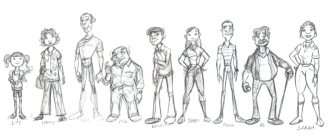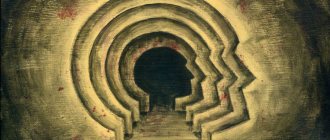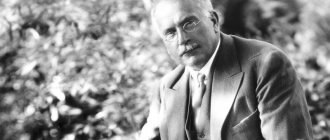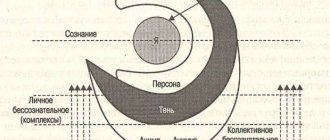Carl Gustav Jung is without a doubt an important name if we want to understand the history of psychology. His theories have been a source of both controversy and inspiration. It is not surprising that he is the founder of his own school of thought in the psychoanalytic field, the school of analytical psychology, also called complex and deep psychology.
For a long time, Jung was a student of Freud. However, he distanced himself from Freud mainly because he disagreed with his theory of sexuality. Moreover, Jung postulated the existence of a “collective unconscious” that precedes the individual unconscious.
“I know what I want: I have goals and opinions. Let me be myself, that's more than enough for me."
— Anne Frank
Jung was a restless intellectual who collected information from a variety of sources. In addition to neuroscience and psychoanalysis, Jung's theories were influenced by mythology, religion, and even parapsychology. One of his great interests was archeology, and this was probably his theory of archetypes. The theory of universal symbols present in the unconscious human mind.
Jung's personality type theory
For Carl Jung there are four basic psychological functions: thinking, believing, feeling and perceiving. In each person one or more of these functions have a special emphasis. For example, when someone is impulsive, according to Jung, it is because their “feeling and perceiving” functions take precedence over their “thinking and believing” functions.
Based on these four basic functions, Jung postulated that there are two basic character types: introvert and extrovert. Each has its own characteristics that distinguish it from the other.
Classification criteria
Jung's typology implies a psychological attitude according to which there are two types of people - extroverts and introverts. According to this teaching, the predominant mental functions are intuition, thinking, sensations, and feelings.
This typology was first presented in the work “Psychological Types,” written by Swiss psychiatrist Carl Gustave Jung in 1921. The purpose of the classification he developed was not to trivially divide people into separate groups according to any psychological characteristics. He wanted to create a special tool for a practical psychologist, with the help of which he could organize the accumulated psychological knowledge, study people, and reduce the number of errors in research.
Extroverted type
Their interests are focused on external reality, rather than on their inner world.
They make decisions by thinking about their impact on external reality, and not on their own existence.
Their actions are carried out in accordance with what others may think about them.
Their ethics and morality are built depending on what prevails in the world.
These are people who can fit into almost any environment, but they really have a hard time adapting.
They are suggestible, easily influenced and tend to imitate others. They need to be recognized by others.
Differences between Freud's psychoanalysis and Jung's analytical psychology
How did Freud's views differ from Jung's? Let's highlight some differences.
1. The main differences between the analytical psychology of Carl Jung and Freudian psychoanalysis concern the question of the nature of libido . If Freud characterizes libido primarily in terms of the sexual sphere, then for Jung libido is vital energy in general, in which sexual activity is present only as one of the components and manifests itself in growth and reproduction, as well as in other activities that are most important for a particular person.
2. Also, Jung rejected the Freudian concept of the Oedipus complex . He explained the child's attachment to his mother by the purely everyday needs of the child, and the mother's ability to satisfy them.
As the child grows, he develops sexual needs that superimpose on the previously dominant needs for food. Jung suggested that libidinal energy takes on heterosexual forms only during puberty. He did not completely deny the presence of sexual forces in childhood, but he reduced sexuality to the position of only one of many drives in the psyche.
3. From Freud's point of view, a person is a product of his childhood experiences. For Jung, a person is determined not only by the past, but equally by his goals, expectations and hopes for the future. In his opinion, personality formation is not completed at the age of five. A person can change, sometimes quite significantly, throughout his life.
According to K. Jung, self-actualization can only be achieved in middle age, and therefore Jung considered this age (35-40 years) as a critical period for personal development - a boundary at which a person undergoes deep and beneficial transformations. Thus, for Jung, the most important stage of personal development is not childhood, as with Freud, but, on the contrary, adulthood, the time when he himself went through a mental crisis and was able to overcome it.
4. Another difference between Freud's and Jung's positions is that Jung attempted to penetrate deeper into the unconscious than Freud did. He added another dimension to the understanding of the unconscious: the innate experience of humanity as a species inherited from its animal ancestors (i.e., the collective unconscious).
Introverted character
On the other hand, the introvert type has the following traits:
They are interested in themselves, their feelings and thoughts.
They orient their behavior according to what they feel and think, even though this may be contrary to external reality.
They are not overly concerned about the impact their actions may have on their environment. They worry about everything that satisfies them internally.
They struggle to adapt to their environment and adapt to it. However, if they manage to adapt, they will do so in a creative and complete way.
Archetypes
Archetypes are innate tendencies within the collective unconscious that are the internal determinants of a person's mental life.
They direct human actions in a certain direction, somewhat similar to the way our animal ancestors behaved in similar situations. Archetypes reveal themselves in consciousness in the form of emotions and some other mental phenomena. They are usually associated with such important moments of life experience as birth and death, the main stages of the life path (childhood, adolescence), as well as with the reaction to mortal danger.
Jung explored the mythology and artistic creativity of a number of ancient civilizations, identifying the underlying archetypal symbols. It turned out that there are a significant number of such symbols that are inherent in all archaic cultures, even those that were so separated in time and space that direct contact between them was obviously impossible. He also managed to discover in the dreams of patients what he considered traces of similar symbols. This further strengthened Jung's commitment to the idea of the collective unconscious.
Four such archetypes are more common than others - Persona, Anima and Animus, Shadow, Self.
1. Anime and Animus archetypes are two components of one whole. They reflect Jung's assumption that each person carries within himself certain psychological characteristics of the opposite sex.
Anima reflects female unconscious (feminine) characteristics in a male character, and animus reflects male unconscious (masculine) characteristics in a female character.
Like most other archetypes, this pair originates in the deepest, most primitive layers of human ancestral experience, when men and women internalized certain emotional and behavioral tendencies of the opposite sex. Thus, every person has feelings, emotions and experiences of both sexes.
These archetypes not only cause each sex to have traits of the opposite; they also act as collective images that motivate each gender to understand and respond to the other.
2. The Persona archetype (Mask) is the mask that each of us puts on when communicating with other people. It includes our social roles and individual style of expression.
A persona represents us as we want to be perceived by society. It may not coincide with the individual's true personality. Jung's concept of Persona is similar to the concept of role behavior in sociology, when we act as we think people expect us to act in certain situations.
A person has both positive and negative aspects. The Dominant Persona can suppress, even stifle, individuality. Those who identify with their Persona begin to see themselves only in terms of their superficial social roles or façade. C. Jung also called the Persona the archetype of conformity. At the same time, the Persona is not only negative, it protects the Ego and the soul as a whole from various social forces and attacks aimed at it.
3. The Shadow archetype is the center of the personal unconscious, a focus for material that has been repressed from consciousness; this is a kind of reverse, dark side of the Self. It is most deeply rooted in man’s animal past. Jung considered it a kind of legacy of lower forms of life.
It includes tendencies, desires, memories, experiences that are denied by the individual as incompatible with his Persona or contrary to social standards and ideals.
The shadow represents the totality of all our immoral, violent, passionate and completely unacceptable desires and actions. Jung wrote that the shadow pushes us to do something that we would never allow ourselves to do in a normal state. When something like this happens to us, we tend to explain what happened by saying that something came over us. This “something” is the shadow, the most primitive part of our nature.
However, the shadow also has its positive side. It is a source of spontaneity, creative impulse, sudden insights and deep emotions, without which a normal, full-fledged human life is also impossible.
4. Archetype Self is the center of personality around which all other systems are grouped. It holds these systems together and provides the individual with unity, balance and stability. This is the central archetype of personality integrity, which integrates the conscious and unconscious in the human psyche.
The Self is both a true subject and an integral personality, and the goal of a person’s life, which he constantly strives for, but which he rarely achieves. Before the self can be embodied, the various components of the personality must undergo full development and individuation. According to K. Jung, a person can achieve balance only as a result of a long process of psychological maturation, which he calls individualization.
Intuitive introvert
These people are extremely sensitive to the most subtle stimuli. Intuitive introverts are the type of people who can almost guess what others are thinking, feeling or wanting to do. They are creative, dreamers and idealists. They struggle with “keeping their feet on the ground.”
- 8 Physical Qualities That Reveal Your Personality
- 2 Personality Traits That Indicate You Have a High IQ
Separation of functions
To specify the descriptions of the human psyche, a Swiss psychologist introduced two new terms - additional and auxiliary function. He made a division according to which he identified two groups:
- rational - thinking, feelings;
- irrational - intuition, sensations.
If any function begins to dominate, it will suppress the others. With the further development of the dominant functions, they are joined by additional ones that begin to accompany them, helping the base to strengthen.
Leonhard's typology
German psychiatrist Karl Leonhard identified 6 types of people in psychology according to temperament.
- Hyperthymic temperament: elevated mood, thirst for activity, disorganization, dislike of strict boundaries and restrictions.
- Dysthymic: depressed mood predominates. Tends to be solitary, slow. Stands out for his serious ethical position.
- Cyclothymic - characterized by periodic changes in mood: when elevated, it develops vigorous activity, when decreased, performance drops sharply.
- Anxious and suspicious - fearful, efficient, worried about failures for a long time.
- Emotive - soft-hearted, compassionate type.
- Affectively - exalted temperament: characterized by a wide range and severity of emotional reactions. He easily becomes delighted for minor reasons, and just as easily falls into despair at the slightest failure.
Leonhard also considered 4 types of people based on the psychology of accentuation. Accentuation of character is the expression of certain psychological traits, as a result of which a person becomes vulnerable to certain psychogenic influences. When accentuation is pronounced, the same type of difficulties and conflicts with others arise. In advanced cases, psychology considers these types of people as a deviation from the norm - psychopathy, which prevents them from adapting to society.
If a person has severe psychological problems, for example, fears, phobias, panic attacks, addiction, etc., he needs the help of a qualified specialist.
The main features of accentuated personalities:
- demonstrative type - a tendency towards posing, artistry, the desire to rise in the eyes of others, which leads to deceit and embellishment of information about oneself;
- pedantic - rigidity, slowness, indecisiveness, accuracy;
- stuck - resentment, a tendency to “get stuck” for a long time on certain thoughts and feelings, especially when it comes to hurt pride, suspicion, jealousy;
- excitable type - impetuosity, impulsiveness, intolerance, imperviousness to criticism.
On the Internet you can find many questionnaires to identify personality accentuation and temperament type. For example, Lichko test, Shmishek test, Eysenck questionnaire.








